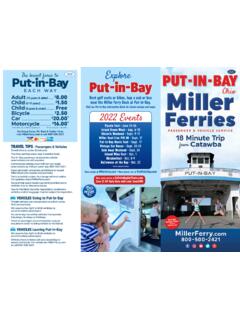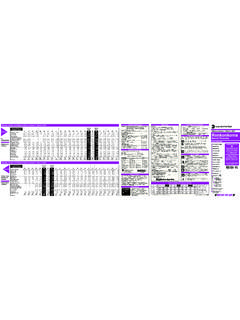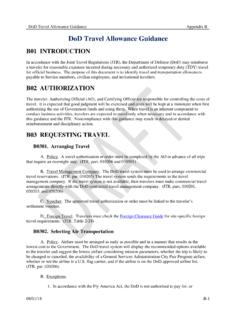Transcription of CHAPTER 17 Information Extraction - Stanford University
1 Speech and Language Processing. Daniel Jurafsky & James H. Martin. Copyright 2021. Allrights reserved. Draft of December 29, ExtractionI am the very model of a modern Major-General,I ve Information vegetable, animal, and mineral,I know the kings of England, and I quote the fights historicalFrom Marathon to Waterloo, in order and Sullivan,Pirates of PenzanceImagine that you are an analyst with an investment firm that tracks airline re given the task of determining the relationship (if any) between airline an-nouncements of fare increases and the behavior of their stocks the next day. His-torical data about stock prices is easy to come by, but what about the airline an-nouncements? You will need to know at least the name of the airline, the nature ofthe proposed fare hike, the dates of the announcement, and possibly the response ofother airlines. Fortunately, these can be all found in news articles like this one:Citing high fuel prices, United Airlines said Friday it has increased faresby $6 per round trip on flights to some cities also served by lower-cost carriers.
2 American Airlines, a unit of AMR Corp., immediatelymatched the move, spokesman Tim Wagner said. United, a unit of UALCorp., said the increase took effect Thursday and applies to most routeswhere it competes against discount carriers, such as Chicago to Dallasand Denver to San CHAPTER presents techniques for extracting limited kinds of semantic con-tent from text. This process ofinformation Extraction (IE) turns the unstructuredinformationextractioninforma tion embedded in texts into structured data, for example for populating arelational database to enable further begin with the task ofrelation Extraction : finding and classifying semanticrelationextractionrelations among entities mentioned in a text, like child-of (X is the child-of Y), orpart-whole or geospatial relations. Relation Extraction has close links to populat-ing a relational database, andknowledge graphs, datasets of structured relationalknowledgegraphsknowledge, are a useful way for search engines to present Information to , we discuss three tasks related extractionis finding eventseventextractionin which these entities participate, like, in our sample text, the fare increases byUnitedandAmericanand the reporting coreference( CHAPTER 22) is needed to figure out which event mentions in a text refer to the sameevent; the two instances ofincreaseand the phrasethe moveall refer to the sameevent.
3 To figure outwhenthe events in a text happened we extracttemporal expres-sionslike days of the week (FridayandThursday) ortwo days from nowand timestemporalexpressionsuch as3:30 , andnormalizethem onto specific calendar dates or times. We llneed to linkFridayto the time of United s announcement,Thursdayto the previousday s fare increase, and produce a timeline in which United s announcement followsthe fare increase and American s announcement follows both of those INFORMATIONEXTRACTIONF inally, many texts describe recurring stereotypical events or situations. The taskoftemplate fillingis to find such situations in documents and fill in the templatetemplate fillingslots. These slot-fillers may consist of text segments extracted directly from the text,or concepts like times, amounts, or ontology entities that have been inferred fromtext elements through additional airline text is an example of this kind of stereotypical situation since airlinesoften raise fares and then wait to see if competitors follow along.
4 In this situa-tion, we can identifyUnitedas a lead airline that initially raised its fares, $6 as theamount,Thursdayas the increase date, andAmericanas an airline that followedalong, leading to a filled template like the : LEADAIRLINE:UNITEDAIRLINESAMOUNT:$6 EFFECTIVEDATE:2006-10-26 FOLLOWER:AMERICANAIRLINES Relation ExtractionLet s assume that we have detected the named entities in our sample text (perhapsusing the techniques of CHAPTER 8), and would like to discern the relationships thatexist among the detected entities:Citing high fuel prices, [ORGU nited Airlines] said [TIMEF riday] ithas increased fares by [MONEY$6] per round trip on flights to somecities also served by lower-cost carriers. [ORGA merican Airlines], aunit of [ORGAMR Corp.], immediately matched the move, spokesman[PERTim Wagner] said. [ORGU nited], a unit of [ORGUAL Corp.],said the increase took effect [TIMET hursday]and applies to mostroutes where it competes against discount carriers, such as [LOCC hicago]to [LOCD allas]and [LOCD enver]to [LOCSan Francisco].
5 The text tells us, for example, thatTim Wagneris a spokesman forAmericanAirlines, thatUnitedis a unit ofUAL Corp., and thatAmericanis a unit binary relations are instances of more generic relations such aspart-oforemploysthat are fairly frequent in news-style texts. Figure lists the 17 relationsused in the ACE relation Extraction evaluations and Fig. shows some samplerelations. We might also extract more domain-specific relation such as the notion ofan airline route. For example from this text we can conclude that United has routesto Chicago, Dallas, Denver, and San relations correspond nicely to the model-theoretic notions we introducedin CHAPTER 15 to ground the meanings of the logical forms. That is, a relation consistsof a set of ordered tuples over elements of a domain. In most standard Information - Extraction applications, the domain elements correspond to the named entities thatoccur in the text, to the underlying entities that result from coreference resolution, orto entities selected from a domain ontology.
6 Figure shows a model-based viewof the set of entities and relations that can be extracted from our running how this model-theoretic view subsumes the NER task as well; named entityrecognition corresponds to the identification of a class of unary of relations have been defined for many other domains as well. For exampleUMLS, the Unified Medical Language System from the US National Library RELATIONEXTRACTION3 ARTIFACTGENERALAFFILIATIONORGAFFILIATION PART-WHOLEPERSON-SOCIALPHYSICALL ocatedNearBusinessFamilyLasting PersonalCitizen-Resident-Ethnicity-Relig ionOrg-Location-OriginFounderEmploymentM embershipOwnershipStudent-AlumInvestorUs er-Owner-Inventor-ManufacturerGeographic alSubsidiarySports-AffiliationFigure 17 relations used in the ACE relation Extraction inTennesseePart-Whole-SubsidiaryORG-ORGX YZ, the parent company ofABCP erson-Social-FamilyPER-PERYoko s husbandJohnOrg-AFF-FounderPER-ORGS teve Jobs, co-founder relations with examples and the named entity types they {a,b,c,d,e,f,g,h,i}United, UAL, American Airlines, AMRa,b,c,dTim WagnereChicago, Dallas, Denver, and San Franciscof,g,h,iClassesUnited, UAL, American, and AMR are organizationsOrg={a,b,c.}
7 D}Tim Wagner is a personPers={e}Chicago, Dallas, Denver, and San Francisco are placesLoc={f,g,h,i}RelationsUnited is a unit of UALPartOf={ a,b , c,d }American is a unit of AMRTim Wagner works for American AirlinesOrgAff={ c,e }United serves Chicago, Dallas, Denver, and San FranciscoServes={ a,f , a,g , a,h , a,i }Figure model-based view of the relations and entities in our sample has a network that defines 134 broad subject categories, entity types, and54 relations between the entities, such as the following:EntityRelationEntityInjurydisr uptsPhysiological FunctionBodily Locationlocation-ofBiologic FunctionAnatomical Structurepart-ofOrganismPharmacologic SubstancecausesPathological FunctionPharmacologic SubstancetreatsPathologic FunctionGiven a medical sentence like this one:( ) Doppler echocardiography can be used to diagnose left anterior descendingartery stenosis in patients with type 2 diabetesWe could thus extract the UMLS relation:4 CHAPTER17 INFORMATIONEXTRACTIONE chocardiography, DopplerDiagnosesAcquired stenosisWikipedia also offers a large supply of relations, drawn frominfoboxes, struc-infoboxestured tables associated with certain Wikipedia articles.
8 For example, the Wikipediainfobox forStanfordincludes structured facts likestate = "California"orpresident = "Marc Tessier-Lavigne". These facts can be turned into rela-tions likepresident-oforlocated-in. or into relations in a metalanguage calledRDFRDF(Resource Description Framework). AnRDF tripleis a tuple of entity-relation-RDF tripleentity, called a subject-predicate-object expression. Here s a sample RDF triple:subjectpredicate objectGolden Gate Park locationSan FranciscoFor example the crowdsourced DBpedia (Bizer et al., 2009) is an ontology de-rived from Wikipedia containing over 2 billion RDF triples. Another dataset fromWikipedia infoboxes,Freebase(Bollacker et al., 2008), now part of Wikidata (Vrande ci cFreebaseand Kr otzsch, 2014), has relations between people and their nationality, or locations,and other locations they are contained or other ontologies offer useful ontological relations that express hier-archical relations between words or concepts.
9 For example WordNet has theis-aoris-ahypernymrelation between classes,hypernymGiraffe is-a ruminant is-a ungulate is-a mammal is-a vertebrate ..WordNet also hasInstance-ofrelation between individuals and classes, so that forexampleSan Franciscois in theInstance-ofrelation withcity. Extracting theserelations is an important step in extending or building , there are large datasets that contain sentences hand-labeled with theirrelations, designed for training and testing relation extractors. The TACRED dataset(Zhang et al., 2017) contains 106,264 examples of relation triples about particularpeople or organizations, labeled in sentences from news and web text drawn from theannual TAC Knowledge Base Population (TAC KBP) challenges. TACRED contains41 relation types (like per:city of birth, org:subsidiaries, org:member of, per:spouse),plus a no relation tag; examples are shown in Fig.
10 About 80% of all examplesare annotated as no relation; having sufficient negative data is important for trainingsupervised Types & LabelCarey will succeed Cathleen P. Black, who held the position for 15years and will take on a new role as chairwoman of Hearst Maga-zines, the company :per:titleIrene Morgan Kirkaldy, who was born and reared in Baltimore, livedon Long Island and ran a child-care center in Queens with her secondhusband, Stanley :per:cityofbirthBaldwin declined further comment, and said JetBlue chief executiveDave Barger was :PERSON/TITLER elation:norelationFigure sentences and labels from the TACRED dataset (Zhang et al., 2017).A standard dataset was also produced for the SemEval 2010 Task 8, detectingrelations between nominals (Hendrickx et al., 2009). The dataset has 10,717 exam-ples, each with a pair of nominals (untyped) hand-labeled with one of 9 directedrelations likeproduct-producer( afactorymanufacturessuits) orcomponent-whole(myapartmenthas a largekitchen).


















